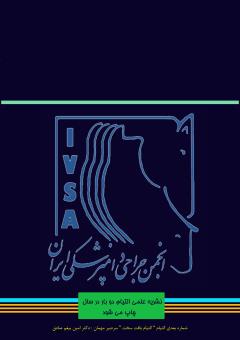Flexural and Angular deformity in the Calves
Subject Areas : Veterinary Soft and Hard Tissue Surgeryhamid reza moslemi 1 * , navid Ehsan pour 2
1 - Assistant Prof., Department of Clinical Sciences, Faculty of Veterinary Medicine, Semnan University, Semnan, Iran
2 - Student, Department of Clinical Sciences, Faculty of Veterinary Medicine, Semnan University, Semnan, Iran
Keywords: Flexural deformity, Angular deformity, Calf,
Abstract :
As the anatomical condition of the limbs is extremely important for production performance, animal welfare, as well as economic consequences, it is very important to study the types of limbs malformations in infants and provide corrective measures. A congenital malformation of the animal's limbs is more common in calves, lambs, and foals, involving flexor and extensor tendons in the fetlock and pastern joints. Deformities of the wrist and palmar-carpal joint in the forelimbs are the most common congenital deformities in calves. A non-surgical treatment is performed in cases whose limbs can be opened with the hand, and the ventral part of the fingers is in contact with the ground. The use of surgical treatment is mainly reserved for severe cases of deformity and calves with insufficient correction after splints and casts have failed. Generally, calves with flexion deformity have a good prognosis. Angular deformity of the limb refers to the deviation of the limb outward (valgus) or inward (varus). An Dorso-Palmar (Plantar) position is necessary to examine and measure the deformity's anatomical position. Angular deformities associated with abnormal bone growth plates can be corrected by removing the bone matrix or delaying on growth plate using of fixation through the growth plate. Furthermore, there are two other surgical methods for correcting angular deformity: osteotomy using the closing wedge and the step-wise method. Angular deformities related to imbalances in growth plates have a good prognosis. Secondary angular deformity caused by orthopedic injuries in the opposite limb has a poor prognosis.
1. Bruijnis MR, Hogeveen H, Stassen EN. Assessing economic consequences of foot disorders in dairy cattle using a dynamic stochastic
simulation model. Journal of Dairy Science. 2010; 93(6):2419-32. 2. Alsaaod M, Huber S, Beer G, Kohler P, Schüpbach-Regula G, Steiner A. Locomotion characteristics of dairy cows walking on pasture
and the effect of artificial flooring systems on locomotion comfort. Journal of Dairy Science. 2017;100(10):8330-37. 3. Susan L. Fubini, DVM, Dipl ACVS , Norm G. Ducharme, DMV, MSc, Dipl ACVS. FARM ANIMAL SURGERY, second edition. ISBN: 978-0-323-31665-1
4. Anderson DE, Desrochers A, Jean G. Management of Tendon Disorders in Cattle. Veterinary Clinics of North America: Food Animal
Practice. 2008;24(3):551–66. 5. Piccione G, Casella S, Pennisi P, Giannetto C, Costa A, Caola G. Monitoring of physiological and blood parameters during perinatal
and neonatal period in calves. Arquivo Brasileiro de Medicina Veterinária e Zootecnia. 2010;62(1):1-12. 6. Fernández-Salas A, Alonso-Díaz M, Martínez-Flores M, Morgado-Ramírez D. Flexor tendon contracture in calf forelimbs: case report.
Abanico Veterinario. 2021;11:1-11. 7. Sato A, Kato T, Tajima M. Flexor tendon transection and post-surgical external fixation in calves affected by severe
metacarpophalangeal flexural deformity. Journal of Veterinary Medical Science. 2020;82(10):1480–83. 8. Leech A. The effectiveness of oxytetracycline in the treatment of calves with contracted flexor tendons. Veterinary Evidence.
2020;7(1):1-12. 9. Fazili MR, Bhattacharyya HK, Mir M, Hafiz A, Tufani NA. Prevalence and effect of oxytetracycline on congenital fetlock knuckling in
neonatal dairy calves. Onderstepoort Journal of Veterinary Research. 2014;81(1). DOI: http://dx.doi.org/10.4102/ojvr.v81i1.710 10. Tschoner TS, K€ostlin RG, Feist M. Corrective Osteotomy of a Metacarpal Deviation Caused by Fracture in a 9-Month-Old German Fleckvieh Heifer. Veterinary Surgery. 2017; 46:130-5.
11. Carlson ER, Bramlage LR, Stewart AA, Embertson RM, Ruggles AJ, Hopper SA. Complications after two transphyseal bridging techniques for treatment of angular limb deformities of the distal radius in 568 Thoroughbred yearlings. Equine veterinary journal. 2012;44(4):416-9.
12. Lozier JW, Niehaus AJ, Austin Hinds C. Closing wedge ostectomy with transfixation pin–cast stabilization for correction of angular limb deformities of the metatarsophalangeal region in four cattle. Journal of the American Veterinary Medical Association. 2017;255:1047-56.

